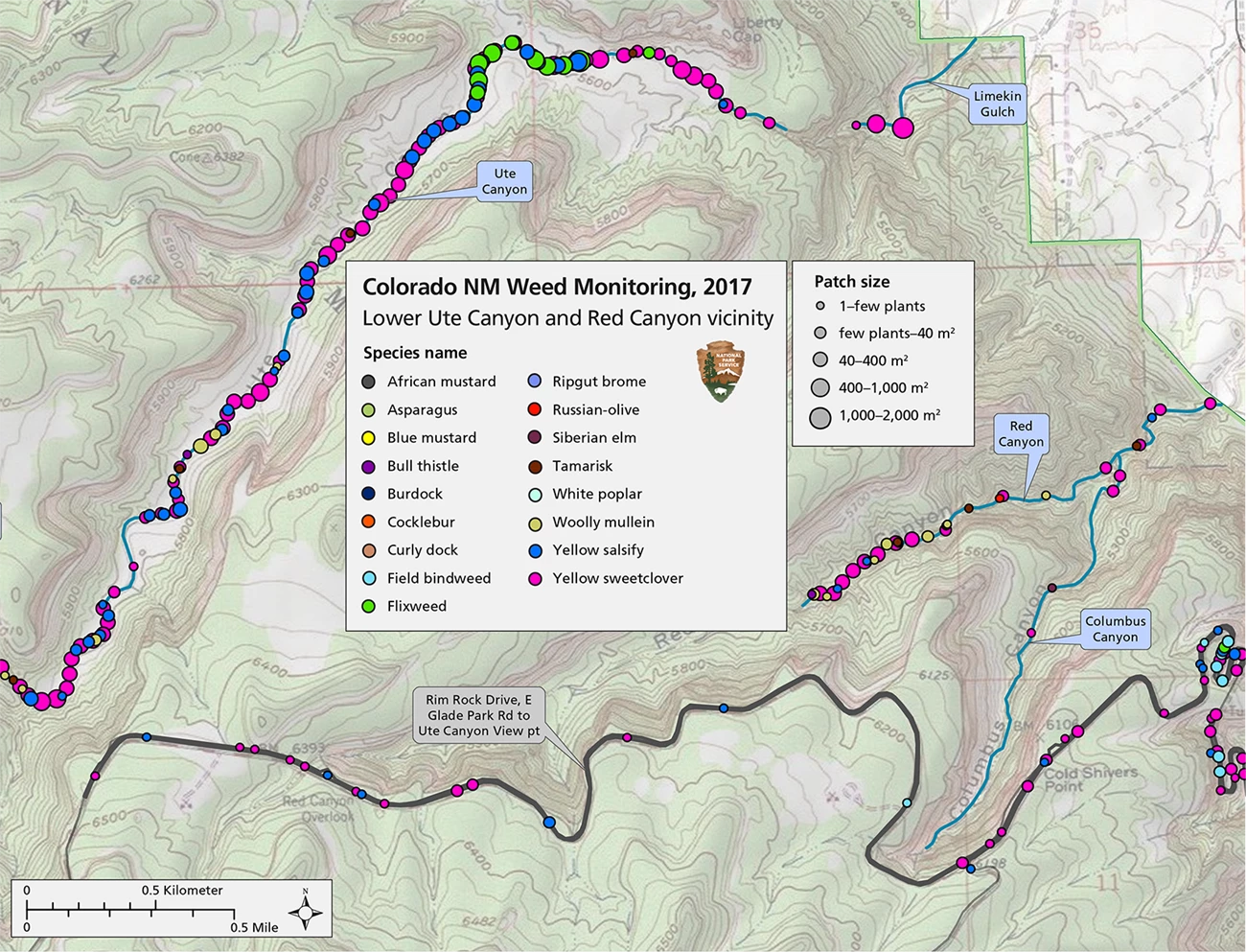Last updated: July 5, 2021
Article
Invasive Exotic Plant Monitoring at Colorado National Monument, 2017

Invasive exotic plants (IEPs) are one of the most significant threats to natural resources in the national parks today. To provide early warning of weed invasions, the Northern Colorado Plateau Network (NCPN) monitors for IEPs in park areas where they are likely to first establish: along roads, trails, and waterways.
Background
Because they are able to reproduce prolifically, rapidly colonize new areas, and displace native species, invasive exotic plants can alter ecosystems at multiple scales. For instance, if an invasive plant doesn’t fill the same ecological role as the native plants it replaces, then the species that depended on the native plants will suffer. In turn, the species that depended on those species will suffer, potentially creating a cascade of negative ecological effects.
Small IEP populations are cheaper and easier to control than large populations. Therefore, early detection is critical. To help park managers identify IEPs and prioritize control efforts, the Northern Colorado Plateau Network (NCPN) monitors invasive exotic plants in eight National Park Service units. First, network and park staff create a list of priority IEPs for each park. On a rotating schedule, a field crew visually surveys for those IEPs along established monitoring routes. Along the routes, they stop and set up plots for additional data collection. The plot data allow network ecologists to estimate trends over time.
During data analysis, a Patch Management Index (PMI) helps identify the scale of the problem presented by each patch of exotic plants. Park managers can use this tool to help prioritize IEP control efforts. PMI multiplies the size of each patch by the amount of each patch that is covered in weeds:
Patch size class (1–5) × Patch cover class (1–5) = Patch management index (1–25)
The PMI score is assigned to a class ranging from Very Low (1) to Very High (5).
When planning IEP control efforts, managers should consider PMI within the context of species and patch numbers. In many cases, directing resources toward controlling patches with Very Low or Low PMI allows managers to eliminate patches before they grow into bigger problems. On the other hand, a species with many patches of Very Low or Low PMI may be harder to treat than a different species with just a few patches of High or Very High PMI.
Recent Monitoring at Colorado National Monument

During monitoring on June 1–7, 2017, a total of 20 IEP species were detected on monitoring routes and transects at Colorado National Monument. Of these, 11 were priority species that accounted for 590 separate patches. Priority IEPs were most prevalent along riparian areas, averaging about one patch every 100 meters surveyed.
Yellow sweetclover (Melilotis officinale), yellow salsify (Tragopogon dubius), and woolly mullein (Verbascum thapsus) were the most commonly detected priority IEPs, representing 86% of all priority patches (see figure above for example). Patches of less than 40 square meters were typical of nearly all priority IEP species except yellow sweetclover. A large majority (89%) of priority IEP patches were assigned “Very Low” PMI, indicating small and/or sparse patches where control is generally still feasible.
Compared to numbers observed in the first year of NCPN monitoring (2009) and earlier (2003) surveys by Utah State University, the number of patches of yellow sweetclover and woolly mullein increased, while the number of patches of Russian olive (Elaeagnus angustifolia), Siberian elm (Ulmus pumila), and tamarisk (Tamarix sp.) decreased. (Patches of tamarisk did rise slightly in number from 2015 to 2017). In 2017, 92% of the tree patches were classified as seedlings or saplings, which require less effort to control than mature trees.
Cheatgrass (Anisantha tectorum) had the highest average percent cover (1.1%) and highest frequency (64%) of all IEPs across all transects. In addition to established monitoring routes, park staff requested surveys of areas near the West Entrance that had and had not previously undergone weed control efforts. Evaluations show that additional invasive species can quickly invade treated areas after target exotic species have been removed. Adding revegetation efforts shortly after future control efforts could help prevent new establishment of invasive plants. Network staff will return to re-sample all monitoring routes in 2019.
For more information, see L. Gommermann, D. W. Perkins, and A. Washuta, Invasive Exotic Plant Monitoring in Colorado National Monument: 2017 Field Season.
